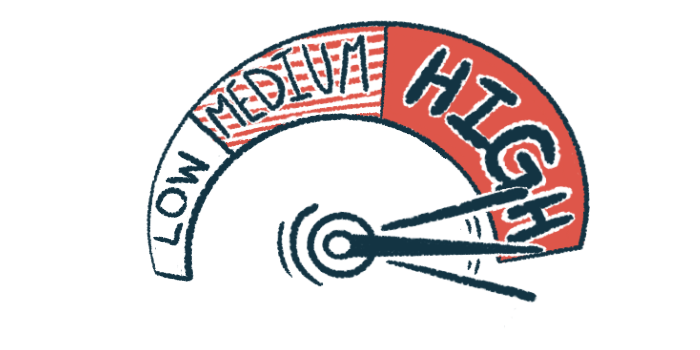High risk of glaucoma found for Cushing’s syndrome patients: Study
Cushing's linked to 74% greater risk of eye condition, earlier age at onset
Written by |

People with Cushing’s syndrome are at a high risk of glaucoma — an eye condition in which the optic nerve that connects the eye and brain becomes damaged, potentially leading to vision loss — according to a new study that found the risk for Cushing’s patients is 74% greater than that of the general population.
Further, the clinical manifestation of glaucoma — the age at onset — occurred earlier among people with Cushing’s, regardless of whether or not they were in remission. In fact, the incidence of glaucoma before age 40 was five times higher for Cushing’s patients than those without the condition, the study found.
Given these findings, the researchers called for glaucoma screenings to be made a routine part of patient care in Cushing’s syndrome.
“Guidelines should also incorporate recommendations for periodic monitoring for intraocular pressure and/or glaucoma development to be routinely performed for patients with [Cushing’s], especially if they also have concomitant comorbidities [other co-occurring medical conditions],” the team wrote, noting “a heightened risk of early-onset glaucoma” for these individuals.
The study, “Higher risk and earlier onset glaucoma in Cushing’s syndrome,” was published in the journal Acta Ophthalmologica.
Researchers launch first study of risk of glaucoma in Cushing’s
Cushing’s syndrome is characterized by hypercortisolism, or high levels of the hormone cortisol, which is produced by the adrenal glands located atop the kidneys. Cushing’s disease, one of the most common forms of the syndrome, is caused by a tumor in the brain’s pituitary gland, which produces excessive amounts of adrenocorticotropic hormone (ACTH), triggering cortisol production.
Treatment commonly involves surgery to remove the tumor that’s causing the condition. After that, patients typically need to take cortisol replacement medications, such as steroids, to maintain cortisol levels within a normal range.
The use of steroids is associated with a higher risk of increased intraocular pressure, or pressure inside the eye, a known risk factor for glaucoma. However, according to the researchers, “glaucoma incidence in patients with endogenous Cushing’s syndrome … has never been established.”
To know more, scientists from Israel and the U.S. conducted a retrospective analysis of 609 Cushing’s syndrome patients who had been diagnosed between 2000 and 2023. The patients had a mean age of 48.1 years, and 65% were women. Additionally, a total of 3,018 individuals without hypercortisolism, matched for age, sex, socioeconomic status, and body mass index, or BMI — a measure of body fat based on height and weight — were included as controls.
In nearly half of the patients (42.6%), Cushing’s was caused by a pituitary tumor, while in 33.8% it was caused by a condition directly affecting the adrenal glands. The disease cause could not be determined for the remaining 23.6% of patients.
Compared with the controls, the Cushing’s patients had a significantly higher prevalence of diabetes, high blood pressure, coronary artery disease — narrowing or blockage of the arteries that supply blood to the heart — abnormal levels of fats in the blood, and stroke.
Overall, 12.8% of the Cushing’s patients and 8.3% of the controls developed glaucoma. Among them, 7.2% of patients and 5% of controls developed the eye condition after the study’s start, or baseline — defined as the time of Cushing’s diagnosis for patients.
A risk assessment analysis then revealed that people with Cushing’s had a 74% higher risk of developing glaucoma compared with matched controls.
High risk of glaucoma found regardless of Cushing’s remission status
Individuals with Cushing’s were generally diagnosed with glaucoma at significantly younger ages than were controls. This was true for patients in whom glaucoma was diagnosed before (56.6 vs. 61.6 years) or after the diagnosis of Cushing’s (62 vs. 66 years). There were no differences in the risk for glaucoma related to the cause of Cushing’s.
According to the researchers, “[Cushing’s syndrome] is associated with increased risk for glaucoma regardless of remission status and develops at a younger age compared with the general population.”
[Cushing’s syndrome] is associated with increased risk for glaucoma regardless of remission status and develops at a younger age compared with the general population..
Data on early disease remission, defined by a decrease in cortisol levels, was available for 471 patients. Of these, 66% achieved remission, while 34% had persistently high cortisol levels.
The risk for glaucoma was equally increased in both groups of patients. However, patients who were not in remission were diagnosed with glaucoma approximately six months earlier compared with those who achieved remission.
“This observation could be attributed to the prolonged hypercortisolaemia in patients with [Cushing’s] without remission, leading to elevated [intraocular pressure] and subsequent development of glaucoma,” the researchers wrote.
The researchers noted that this study was “the first of its kind to assess the risk for glaucoma in patients with [Cushing’s syndrome].”







